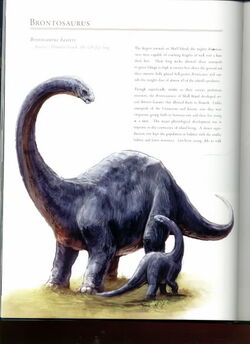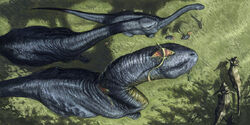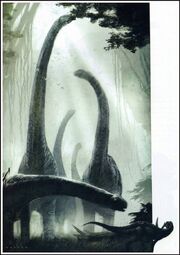
The Brontosaurus, Brontosaurus baxteri, is an enormous, viviparous apatosaurine diplodocid from Skull Island that is easily the largest animal on the island, descended from Brontosaurus excelsus. It measures 80-120 feet long. A close relative also living on the island is Asperdorsus.
The largest animals on Skull Island, the mighty Brontosaurus are capable of reaching lengths of well over 100 feet. Their long necks allow these sauropods to browse foliage as high as 20 feet above of the ground and their massive bulk places full-grown Brontosaurus well outside the weight class of almost all of the island’s predators.
Though superficially similar to their extinct prehistoric ancestors, the Brontosaurus of Skull Island have developed several distinct features that allow them to flourish. Unlike sauropods of the Mesozoic era (as well as most other dinosaurs in general), they are viviparous, giving birth between one and three live young at a time. The major physiological development is in response to the constraints of island living. A slower reproduction rate keeps the population in balance with the smaller habitat and fewer resources. Live born young, able to walk within hours of birth, reduce juvenile mortality thanks to the security afforded to them by being able to move within the safety of the herd.
Young are cared for and protected by all other members of the herd, which can number between 6 and 20 individuals. Regardless of their parenthood, all members of the herd will share duties of protecting young from predators. As they mature, young females will leave to join other herds, while young males stay with the group to assist in defense. The sheer size of the adults protects them from almost all of the island’s predators, but young are at risk from V. rexes and other large carnivores. With a single adult male leading each herd, younger males are inhibited from achieving full ma

turity by pheromones exuded by the lead male, ensuring he fathers all the herd’s offspring. Immature males, rarely achieving even the size of mature females, are therefore more likely targets for marauding V. rexes, effectively decoys for breeding stock of the herd.
Brontosaurus is the tallest herbivore on the island, browsing on the highest of branches at 55 feet above the ground, while the Ligocristus and other midsized herbivores browse on smaller trees that are typically 25 feet above the ground. Ceratopsians (namely Ferrucutus) feed on the low shrubs, ferns, and grasses that grow 4.5 feet tall or shorter, and smaller plant-eaters (like Pugiodorsus and certain flightless birds) feed around them at ground level (or at 10 feet above the ground); thus each herbivore species avoids competing with each other for food.
When the herd is separated during feeding, Brontosaurus communicate with one another by stomping signals that are transmitted

through the ground over short distances and received by other members of the herd through the pads of their feet. Simple alarms can be easily transmitted by individuals feeding on the outskirts of the family group, alerting the entire herd to any danger.
Apart from their size, the primary defense mechanism of a Brontosaurus is its strong tail. When threatened, a well-aimed swipe can wind or even injure an unwary predator.
The towering herbivores are also responsible for clearing old and new areas of forest growth in their quest for the most digestible food sources. Moving through the jungle between the open lands, families of Brontosaurus create game trails, clearing paths through the thick forest with their great strength.
Skull Island dung beetles will follow herbivores like these and eat their feces.
Skeletal Structure[]
Sturdy skeletons support the great hulk of the Brontosaurus. Stocky legs with incredibly dense limb bones support the creature’s mass. Capable of running only for short bursts when threatened, they are not built for sprinting and, being so heavy, will tire quickly. The teeth are short and stubby, designed for tearing off pieces of vegetation. Stones in the gizzard aid digestion of foliage that is bulk-loaded and swallowed without being chewed.
Relationship with Venatosaurus[]
Venatosaurus is the only predator species that actively preys on adult Brontosaurus. No other predator on the island, including the mighty V. rexes, can match the size of the prey they bring down. Packs split, certain members strategically revealing themselves to panic and stampede a Brontosaurus herd in a predetermined direction. Flankers take up the chase, molesting the giants onto a course they have selected; across dangerously broken ground, over bluffs, or into dead ends. Injury or death among the herd lays meat upon the Venatosaurus’ table, rewarding their cunning with rich bounties of carcasses large enough to feed a pack for a week or more.
The crumbling pre-native ruins dotting Skull Island create unusual landscapes that Venatosaurus learn to use to their benefit. Herding prey, such as Brontosaurus, down what must once have been streets and into cul-de-sac courtyards, hunting packs make use of the alleyways and channels between buildings to afford them ambush sites and parallel paths to outrun and outflank intended victims once a chase has begun. These tactics require fewer hunters to accomplish the same job. Broken ground and gulches created by the ruins make effective traps for Venatosaurus to drive the prey into for slaughter.
